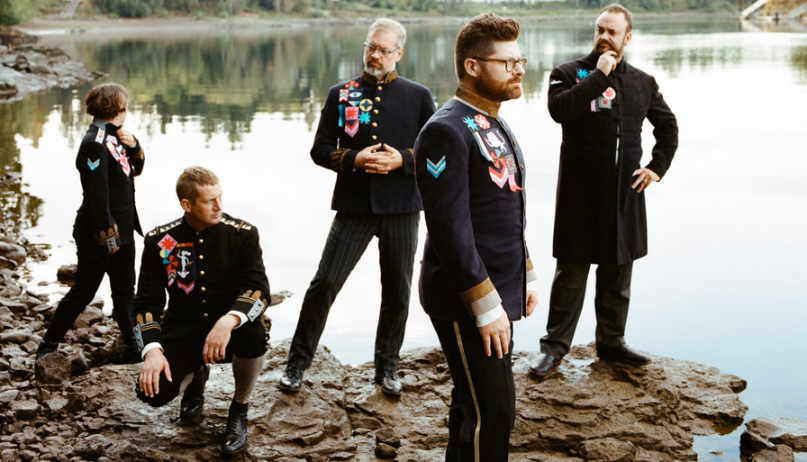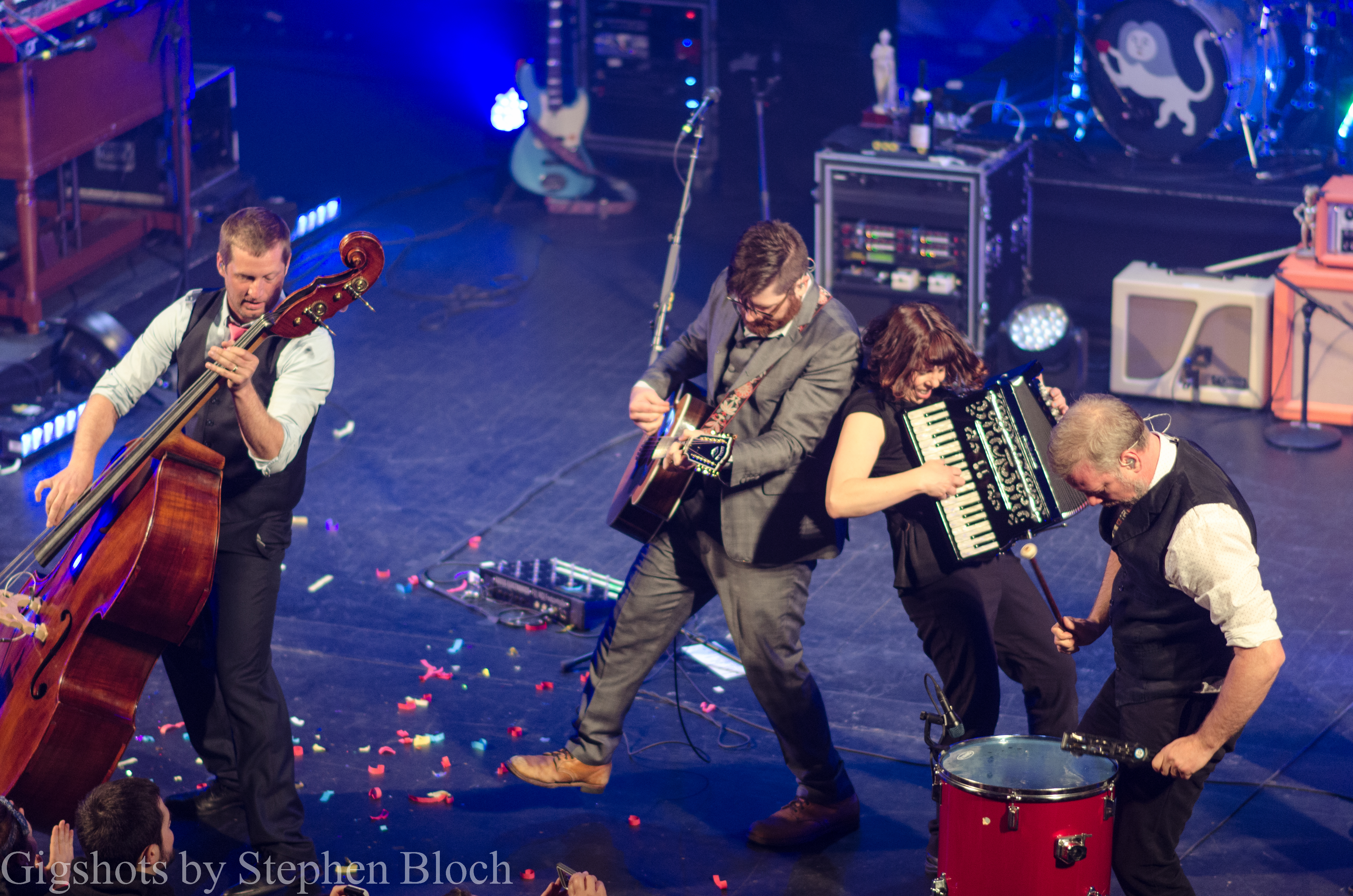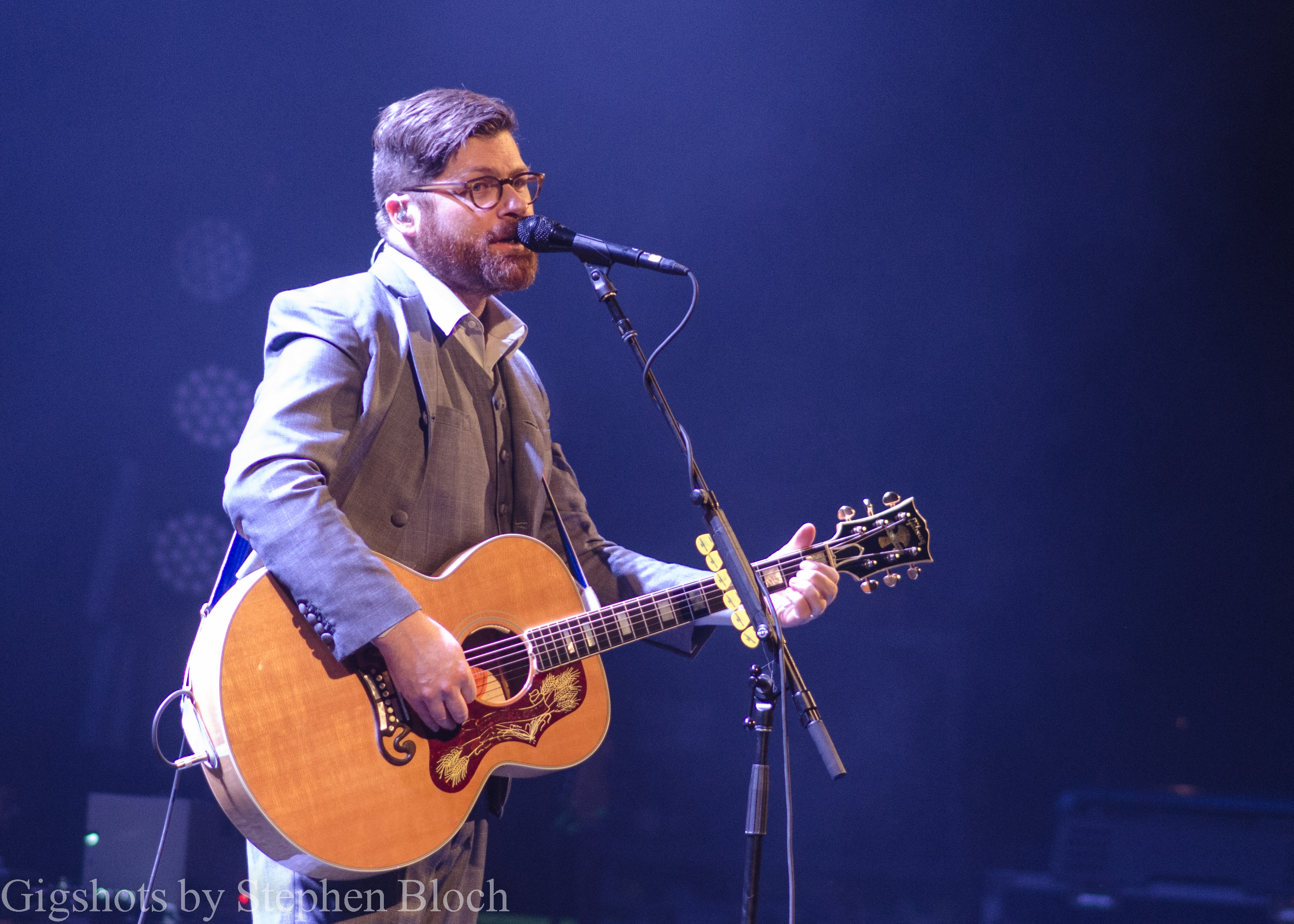The Decemberists: ‘Worlds’ of Ice and Fire

Colin Meloy is often pigeonholed as a rigidly bookish songwriter—a man armed with a grand vision and a grander thesaurus. Indeed, he often composes within the framework of a larger concept, whether it’s an overarching lyrical theme (the Japanese folk tale that informed 2006’s The Crane Wife, the mystical rock-opera structure of 2009’s The Hazards of Love) or a specific sonic approach (the American folk stylings of 2011’s The King is Dead). But when he and The Decemberists entered the studio in May of 2013, the band’s creative direction was unclear—by design.
“The concept was ‘no concept,’” says the Portland-based frontman, surveying the leisurely, scattered construction of their seventh studio album, What a Terrible World, What a Beautiful World. “Every record, to a certain degree, is conceptual. With King Is Dead, we had an idea going into it: ‘This is going to be a more sparse, American folk record, and we’re gonna record it in a barn.’ So we had these preconceived ideas. But the idea with the new album was that we’d just keep working and follow the lead of the songs, and inevitably, that would lead us to some kind of through line—something would marry these songs together. And that process went until the very end.”
Without a clear artistic target, The Decemberists had to become more instinctual, trusting in the power of their collective musicianship and Meloy’s varied storytelling. And they ended up with their most disparate collection of songs—an album that thrives on its own messiness. There are bluesy, traditional-sounding folk ballads (“Carolina Low”), yearning indie-rock epics (“Make You Better”), lush, lusty sing-alongs (“Philomena”) and threadbare reflections on family and loss (“12/17/12”). That variety is a refreshing change of pace, showcasing all of the band’s influences and idiosyncrasies, instead of focusing on one.
In the summer of 2013, The Decemberists booked three days with longtime producer Tucker Martine at his Portland, Ore., studio, Flora Recording. Meloy had barely seen the rest of his band since the conclusion of their King Is Dead tour. Instead of following his usual process of passing out demos, he simply strummed out a few rough ideas lingering in his head. “We sat down, and I played through a few of them, and everybody kind of elected which songs they wanted to work on,” he says. “Nobody had any preconceived notions about what instrument they should be playing, so people would just grab whatever instrument was at hand. That was a really nice exercise.”
Out of that initial session came three tracks, including the sultry, Nick Drake-tinged “Lake Song,” which was recorded live with “just everybody sitting in the room together.” But after that three-day session ended, the band packed up and left—triggering a six-to-eight- month “honeymoon” phase of low-key recording bursts. Instead of adhering to the demands of a label executive’s ticking watch, the band worked at their own patient pace. And that relaxed creative process was an extension of their collective headspace during the previous three years. After wrapping up live dates for The King Is Dead in mid-2011, the group took a hard-earned break—not the exaggerated “hiatus” reported by reputable music outlets, but simply a respite from spinning on the exhausting album-tour wheel. Meloy used his downtime for non-musical pursuits—like writing two more books in his Wildwood children’s series and expanding his family. (His second son, Milo Cannonball, was born in 2013.)
“It just gave me some breathing room,” he says of this misinterpreted intermission. “The whole thing got overblown. I think by even saying we were taking a break, it gave people license to make some assumptions about that or read it wrong. It was this endless game of telephone, so in retrospect, I should have just kept my mouth shut. It will be four years between records, and there are plenty of bands that do that without saying anything. It’s not that much of a break, and that’s what I’d been anticipating all along— that size of a break. I was able to be at home and work on these books. We had another kid. I think if you get too far into the record- release-tour music cycle your life could just disappear before your eyes. And that’s what I was starting to feel.”
The other four Decemberists—string whiz Chris Funk, multi- instrumentalist Jenny Conlee, bassist/cellist Nate Query and drummer/ guitarist John Moen—maintained their collective momentum as a unit, focusing on the progressive-bluegrass outfit Black Prairie that Funk, Conlee and Query co-founded in 2007. (They have four studio LPs under their belts, including 2014’s Fortune.)
“When The Decemberists aren’t active, I just hunger to do other things,” says the versatile Funk. “The momentum? It keeps you sharp in the studio and keeps you creative—having other projects.”
Growing up in Valparaiso, Ind., Funk discovered his passion for an array of musical styles—playing saxophone in his high school’s jazz band and catching punk shows in Chicago. He also developed a deep love for bluegrass after working in a local folk music shop and trying out new instruments, including the pedal steel, which helped him secure his Decemberists gig at the band’s outset. The guitarist also has major respect for the Grateful Dead—The Decemberists even covered “Row Jimmy” for a limited release on Record Store Day in 2010. “I’d say everybody in the band likes them,” he says. “I caught tons of Dead shows back in the day, in the late ‘80s and early ‘90s. I think I was at Brent Mydland and Jerry Garcia’s last shows in Chicago. To me, the word ‘jamband’ hadn’t been invented yet. They were like a psychedelic-rock band to me. They’re amazing.”

What a Terrible World, What a Beautiful World, more so than even The King Is Dead, feels like a true synthesis of all those influences: meshing that album’s twang with the elegant dreaminess of Picaresque and the widescreen bombast of The Crane Wife. Those familiar elements combined in a brand new way.
Without a deadline hanging over their heads, the band wrote music without any expectation of a tour or album. “I could just sit and work on songs,” Meloy says, “like I did before this became my full-time job—when I was just writing songs for the hell of it, for my own enjoyment, without any idea of there ever being any audience for it.”
Meloy gradually assembled enough material for a double LP (a release method that the band considered at one point), drawing inspiration from his growing family, childhood memories and the horrors of modern life. Their stop-start recording process also allowed The Decemberists the necessary perspective to deconstruct and reassemble the tracks.
“That was something we’d never done before,” Meloy says. “I’d always had a handful of songs, and we booked time in the studio, rehearsed the songs, and recorded them in a four- or five-week stretch. That process, I’ve found over the years, doesn’t give you a lot of opportunity to dramatically rethink anything. And whatever song didn’t quite get all that attention gets shelved away to the outtake list of history. But with this record, everything got its fair shake. I definitely polled for quality. I had three years of material to weed through, so I felt strongly about the songs that we did. It sounds cheesy, but it was kind of up to the songs themselves to hold up, rather than us having to abandon them because we took a wrong turn and don’t have time to re-record or retry it. So there are a couple of songs on this record that were recorded a few times—and then we tore them back down to the studs on the third time and rebuilt the whole thing. That’s something we never would have been able to do under our traditional work mode.”
“It’s the old way, honestly,” adds Funk, comparing the process to the band’s first album, 2002’s Castaways And Cutouts (back when there was no pressure because “no one gave a shit”). “It’s the way people typically make records, but The Decemberists got into, not a habit, but the idea of just getting excited about making records, always kind of building a theme—whether it’s a very ham-fisted idea of a rock opera with The Hazards of Love or setting out to make this record like The King Is Dead, which was going out to a barn and trying to evoke those images. Once upon a time, we were just people working at restaurants and washing dishes and making pizzas, and then, making records—and we just hit the road and got lucky.
“We recorded the entire thing over the span of about a year and a half, but that wasn’t a lockout,” he continues. “The longest time we were there was maybe two weeks. I liked it. It was a lot less self- pressure. You start losing perspective if you’re doing something over and over in this vacuous structure, not having a day to go do other things. It’s not healthy. I produce bands, and that’s always a young band’s perspective: Go to a mansion and record for 14 hours. And you just waste time, become unproductive. It just becomes like The Shining. It was nice to do it this way and not have a set release time—‘We’ll get it done when we get it done.’ Thankfully, the people at Capitol are nice enough to let us take our time. We’re in a lucky position because we’re a band who sells a lot of records. We’re not Lorde, but we chart. Somehow, we’ve managed to skate along and have a lot of economy and freedom.”
From a lyrical perspective, What a Terrible World, What a Beautiful World is an extension of The King Is Dead, with Meloy simplifying and focusing his language, using fewer words to paint the same vivid imagery. But it’s a more personal album, with several songs directly referencing his family and the band itself. A good example is “Mistral,” a country-tinged sing-along that paints a straightforward portrait of the musician overcoming a disastrous day (and a wrecked rental car) by “eking out a little joy” with his pregnant wife and son. With its traditional folk structure and foreboding tone, “Better Not Wake the Baby” might come across as one of the singer’s fanciful literary tales—but on closer inspection, it also sounds like the simple story of a red-eyed Meloy trying to get some sleep with a newborn around the house.
“I think it’s often been levied at The Decemberists that we work exclusively in narrative songs, that they’re separate from me and my experience,” Meloy says. “But if you really go through our disco- graphy, you’d find, especially early on, it’s almost 50/50. There’s still a lot of my own voice in those songs—it’s just that the narrative songs tend to get the attention. So I’m not a stranger to that, but definitely with this record, it’s a lot more reflective and introspective, with more general daily observations of myself and my family and my experiences and my memories. I feel the first-person pronoun looms large on the record. You shift, you change—I’m not quite as overt, not so concerned about being as cheeky as I used to be. Maybe that’s age, or maybe that’s just done with being cheeky for the time being. A lot of the songs on this record have been kind of an exploration for me.”
In the album’s hilarious and epic opener, “The Singer Addresses His Audience,” a pop-star narrator examines the strange, symbiotic relationship between a band and its obsessive fans. “We know we belong to ya,” Meloy sings over a simply strummed acoustic, as the other Decemberists gradually layer in jagged guitars, strings and choirs. “We know you built your lives around us/And would we change?” he asks. “We’re aware that you cut your hair in the style that our drummer wore in the video/But with fame came a mounting claim for the evermore, you know/So when your bridal processional is a televised confessional to the benefits of AXE Shampoo/you know we did it for you.”
“I’m both the singer and not the singer in that song,” Meloy says. “In some respects, I feel like that’s the voice of a boy band or some sort of pop diva—just so enamored of its fans. Finding a point where the fans and the artist become one is almost this weird, codependent relationship where the audience insists so much of the artist, and it’s this sort of weird reflection of the audience, and the artist is expected to keep that sacrosanct. And how falling away from that kind of agreement, that contract, is done often just to walk the lawn. You find out that the artist has done everything not just to belong to the audience, but to belong as a human being. So it was just an exploration of that mindset—why people even do music. Why do we throw ourselves out there? Why do we need that feedback? I don’t know that it gives any answers, but I think it creates a nice portrait, anyway.”

The album’s emotional centerpiece is “12/17/12,” which Meloy wrote in a haze after watching President Obama’s national address following the tragic school shooting in Newtown, Conn. Over a sparse kick drum and acoustic guitar, Meloy sings from a place of both profound sadness and joy, clinging to his family in the face of unspeakable horror. “And oh, my love, if you only knew how I longed for you,” he sings to his unborn child. “How I waste my days wishing you would come around/Just to have you around/And what a dear, what a sweet little baby, this cannonball in the bosom of your belly/ Just a kick in your belly.”
“I think there’s a certain amount of hopelessness; there’s so little we can do,” Meloy says, reflecting on the track. “The instinctive thing is to immediately take stock of what you have. And that’s a real, good human reaction to these things. What are truly the things most important to us in our lives? But also, this reflection that there’s this tremendous loss. It’s this weird feeling: ‘Look at me. I have all this in the face of this tragedy, yet my life feels complicated or there are hardships.’ But it was sort of a meditation, really. I think I had been playing around with the chord progression and that melody that day, and I’d watched the address where he listed all the victims. And, like anybody, I was so affected by that—there was some sort of fire that needed an outlet. It happened that I’d been working on this song, and I turned it into this meditation for some kind of outlet for my anger, for my deep sorrow, and it comes out the other end with recounting the great things and the love I have around me.”
For the past four albums, The Decemberists’ not-so-secret weapon has been Martine, whom Meloy considers a true member of the band. “In some respects, he had a greater collaborative contribution to the record than anybody else,” the frontman says.
“He and I worked closely at the outset, where it didn’t make sense to bring in the band, to figure out what direction it was going. It is a collaborative thing among all the band members, and everybody brings all their ideas to the table, but you get to the point of ‘too many cooks in the kitchen,’ and it helps to have a single focus or voice guiding the way.” Like every other Decemberists album, the sprawling What a Terrible World, What a Beautiful World was constructed as a lyrical and sonic journey. It isn’t bound by a singular thread, but that eclecticism forms its own unique flow nonetheless. And Meloy says that’s the entire point—that in our age of Spotify playlists, with the history of recorded music only a click away, there’s a timeless beauty to the album format.
“I know everybody says that nobody listens to music that way anymore, but that’s important to me,” he says. “I like the idea of making a record that’s intentionally sequenced, where you want to sit down and listen to it from start to finish to understand the intent of the artist.”



















